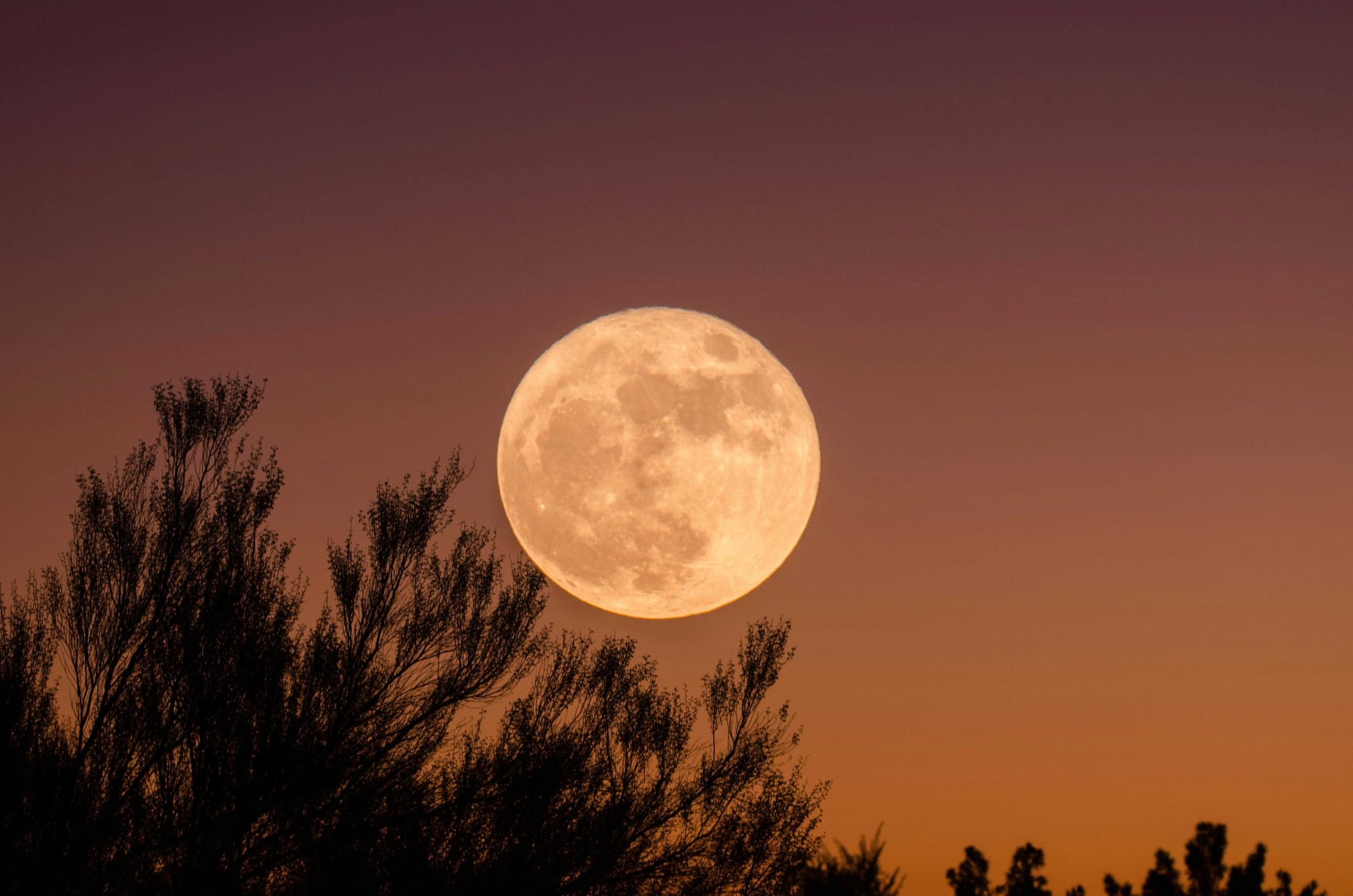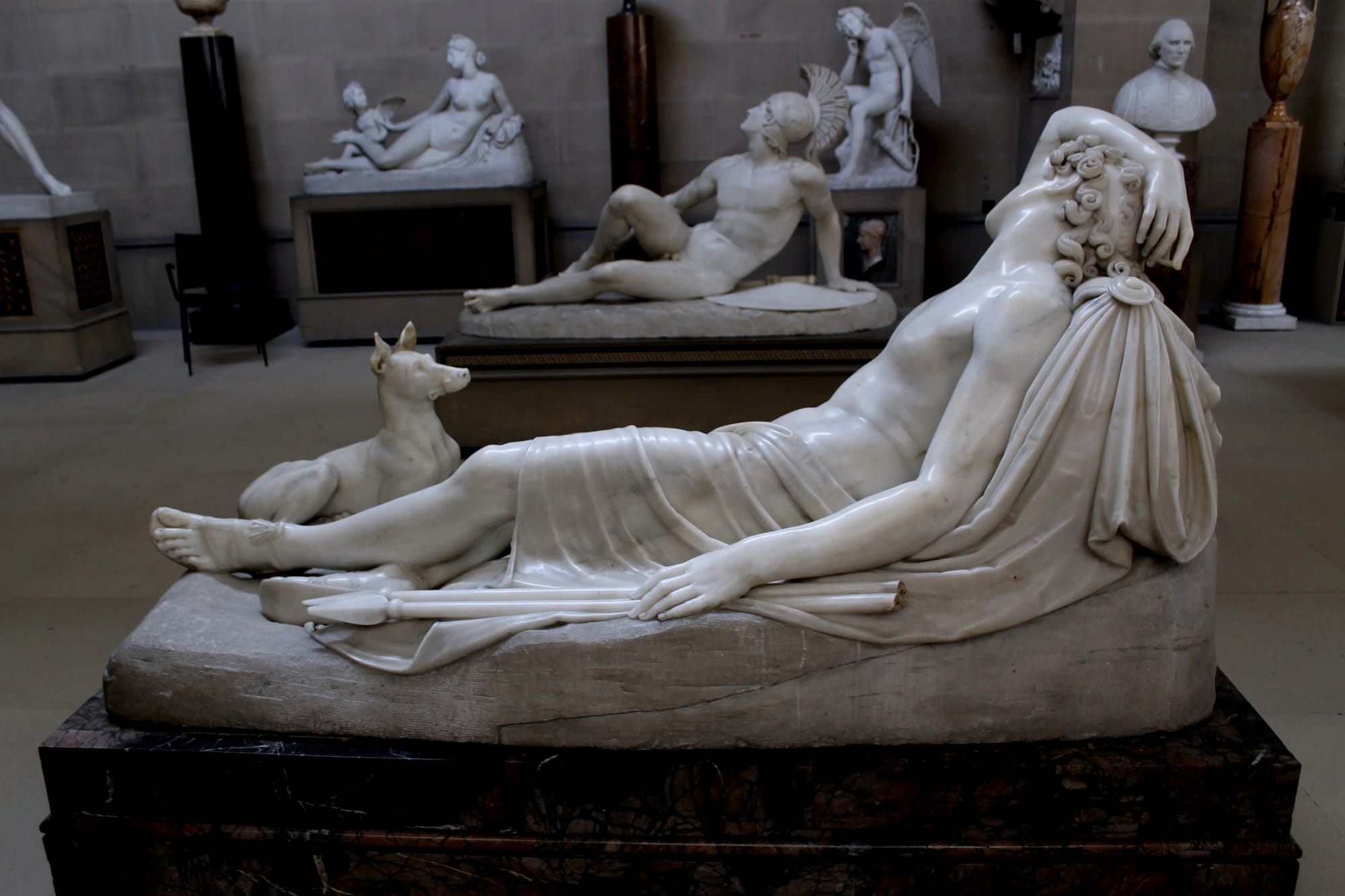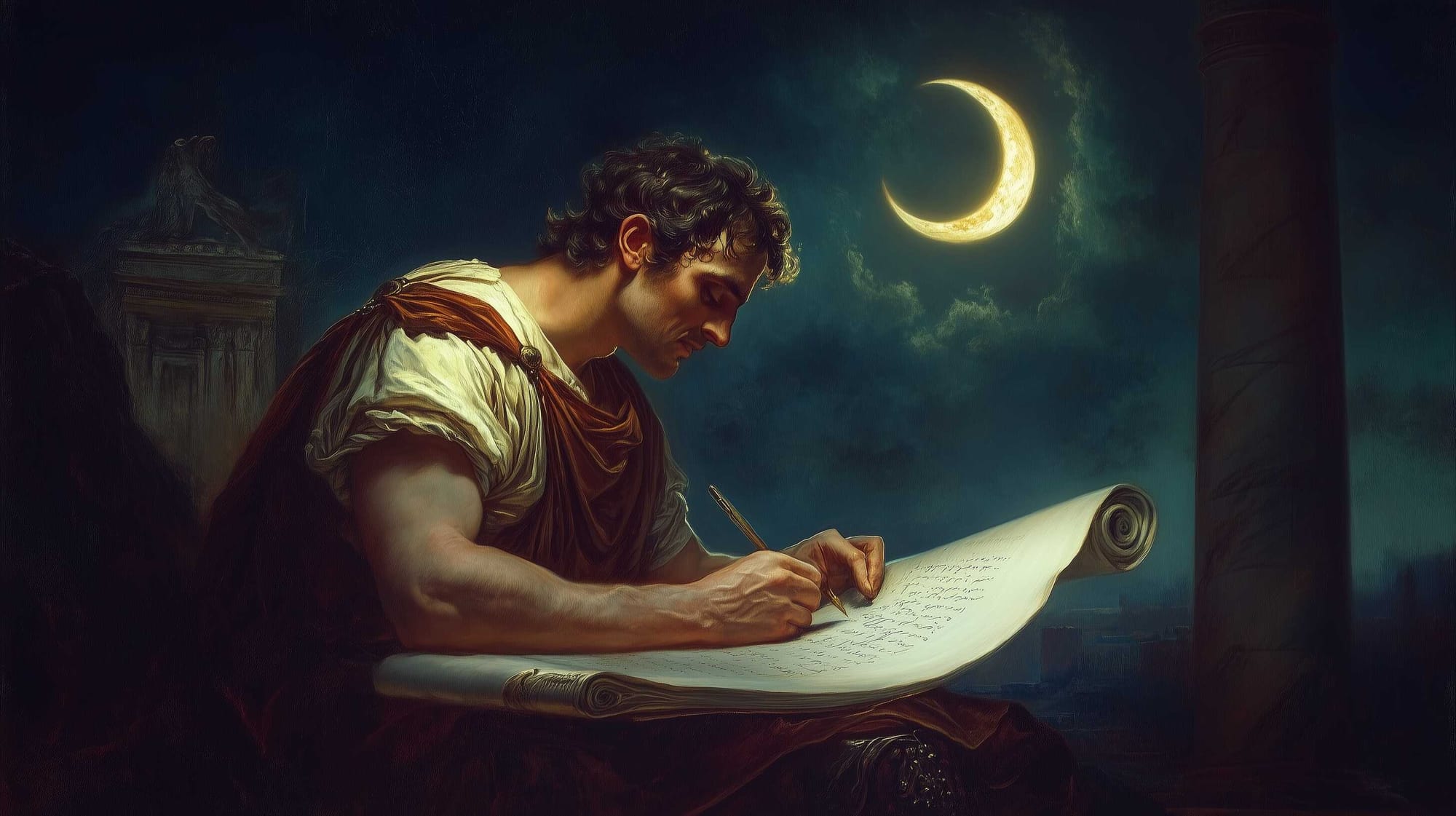August Super Moon is coming. How did Romans “see” the Moon?
The moon's influence was acknowledged and respected in various aspects of Roman life.

The moon played a foundational role in the local calendars of the Greeks, as evidenced by documents and literature from the Late Bronze Age through the Imperial Roman period. Additionally, there are indications that the earliest Roman calendar also acknowledged the moon in its monthly divisions.
The full moon of August in 2024 will reach its peak on August 19th and has been named the "Sturgeon Moon." After sunset, if you look towards the southeast, you'll see the "Sturgeon Moon" rising in the night sky. The August full moon is called the "Sturgeon Moon" due to the Native Americans, who used to fish for this particular fish around this time of year.
During the summer months, especially in August, the Moon appears larger than it does during the rest of the year. It often takes on a deeper and redder hue. This occurs because, during this period, the Moon is positioned low on the horizon, causing its light to refract, which gives it a darker shade. This effect is even more pronounced during moonrise, which happens around the same time as sunset. The upcoming moon is also being referred to as a "supermoon."

In fact, it is the first of four consecutive supermoons that will occur this year (August, September, October, November).
Credits: Ganapathy Kumar / Unsplash
The term "supermoon" was first used by astrologer Richard Nolle in 1979. According to the organization "Earth Sky," the term refers to full moons that occur when the Moon is closer to the Earth's orbit than usual (no more than 10% farther from the closest possible point to Earth). Compared to eclipses, people tend to favor admiring the full moon, especially because during a supermoon, the Moon can appear up to 14% larger and 30% brighter compared to a regular full moon.
The Roman goddess Luna
In Sabine and ancient Roman religion, Luna is the divine representation of the Moon and is often considered the female counterpart to Sol, the Sun god. She is sometimes part of the Roman triple goddess along with Diana and either Proserpina or Hecate. Luna isn't always seen as a separate goddess but can be an epithet used for other goddesses like Diana and Juno, who are also associated with the moon.
In Roman art, Luna is depicted with a crescent moon and a two-yoke chariot (biga). Horace, in his Carmen Saeculare, calls her the "two-horned queen of the stars." Varro classified Luna among the visible gods and considered her one of the deities that secretly protected Rome. In the Imperial cult, Sol and Luna symbolized Roman rule's global reach and the peace it sought to maintain. Luna's Greek equivalent is Selene, and Roman culture adapted many of Selene's myths, such as the story of Endymion, under Luna's name.

The importance of the Moon in Roman farming
City dwellers may did not have fully appreciated the beauty and practical value of a full moon, but for those living in the countryside, where a moonless night was illuminated only by a lantern, the moon was much more significant.
For them, and the ancient Roman farmer, the moon's phases—from crescent to full and back—were a source of wonder, anticipation, aesthetic pleasure, and practical usefulness. The Roman farmer used the moon's cycle as the basis for his calendar, creating a simple almanack that guided activities like planting, harvesting, and other farm tasks according to the moon's phases.
Although much of this moon-related knowledge wasn't written down, enough has been preserved in Latin literature to show that Roman farmers, like their modern descendants, timed their agricultural work by the moon. Their primary concern was ensuring successful crops.
Both Greek and Roman farmers believed that the moon played a role in producing the heavy dews essential for their crops. This belief led to the notion that dew gradually increased from the new moon to the full moon, and as a result, many earthly things, including crops, were thought to be influenced by the moon's phases.

As Palladius put it, "all planting should be done when the moon is increasing."
Roman farmers sowing their forage crops under the moonlight. Illustration: Midjourney
Columella, (Lucius Junius Moderatus Columella was a prominent Roman writer on agriculture in the Roman Empire), added that beans should be planted on the fifteenth day after the new moon, as long as "the moon was not on the wane," or on the fourteenth day if it was still increasing. He also suggested sowing beans just before or on the full moon and recommended that lentils "should be planted before the twelfth day of the moon," to ensure quick growth.
Pliny noted that it was "popularly believed" that forage crops should be sown during the dark of the moon, and that hotbeds should be prepared when "the moon is above the earth" (cum luna supra terram sit). Trees were also planted according to the moon, with Cato advising that fig, apple, olive, and pear trees, as well as vines, should be planted "in the dark of the moon" and in the afternoon when there was no south wind. Columella concurred, suggesting that "all trees should be planted when the moon is increasing."
These sources consistently agree that planting should occur either during the dark of the moon or while it is waxing, with the reasoning that as the moon increases, so will the crops. However, Vergil, in the Georgics, mentions that the seventeenth day after the new moon is favorable for planting vines, which is during the waning moon and contradicts the other sources. This exception is intriguing as it differs from the commonly accepted practice of planting during the waxing moon. (The Roman Farmer and the Moon by Eugene Tavenner)
“All vegetable productions are cut, gathered, and housed to more advantage while the moon is on the wane than while it is on the increase.
Manure must never be touched except when the moon is on the wane; and land must be manured more particularly while the moon is in conjunction, or else at the first quarter.
Take care to geld your boars, bulls, rams, and kids, while the moon is on the wane. Put eggs under the hen at a new moon. Make your ditches in the night-time, when the moon is at full. Cover up the roots of trees, while the moon is at full. Where the soil is humid, put in seed at the moon's conjunction, and during the four days about that period.
It is generally recommended, too, to give an airing to corn and the leguminous grains, and to garner them, towards the end of the moon; to make seed-plots when the moon is above the horizon; and to tread out the grape, to fell timber, and to do many other things that have been mentioned in their respective places, when the moon is below it.”
Pliny, The Natural History, The revolutions of the moon.

Man on the moon? A practical joke in Endymiones by Varro
One of Varro’s Menippean satires, Endymiones, is widely believed to feature a journey to the Moon. In its plot, Luna had another mythical consort named Endymion. While Endymion might have been an astronomer, he is primarily known as a strikingly handsome young shepherd, blessed by Jupiter with the gift of eternal youth and the ability to sleep as long and as often as he wished. Luna was so captivated by his beauty that she descended from heaven every night to watch over and protect him.
Considering that Varro's Menippeans are typically dated between 80-67 BCE, this would make the traveler in Endymiones the earliest "astronaut" in surviving Graeco-Roman literature, predating the lunar adventures in Antonius Diogenes’ The Incredible Things Beyond Thule by over a century, and Lucian’s Icaromenippus and True Stories by nearly two hundred years.
However, it is likely that the lunar journey in this work was more of a fantasy, placing Endymiones within the tradition of imagined philosophical soul-journeys rather than actual voyages to the Moon. Nonetheless, the satirical context in which this journey appears in Varro’s work is significant.
Interpreting Varro’s text is difficult due to its fragmentary state, making the exact theme and plot of Endymiones a subject of debate. Some fragments hint at an evening meal that may have served as the backdrop for a philosophical discussion, a common motif in Varro’s Menippeans.

The title Endymiones is central to the lunar theme, as Endymion, in mythology, was a handsome youth whom the moon goddess Selene loved and visited in secret. The name "Endymion" became associated with deep sleep, leading some scholars to suggest that Endymiones could have been a satire on sleep, perhaps even a response to Naevius’ comedy Agrypnountes ("The Sleepless Ones"). However, there is also strong evidence linking Endymion to astronomy and the Moon.
For example, Mnaseas of Sicyon, a third-century BCE travel writer, claimed that Endymion was the first to discover "the course of the Moon" (cursus lunae), after which he fell asleep for thirty years because he had no further ambitions. This detail, noted by Germanicus in his commentary on Aratus’ Phainomena and later mentioned by Pliny the Elder and Lucian, suggests that Varro’s title could be a satirical reference to contemporary astronomers.
The plural form "Endymiones" is also intriguing and not unique. In his treatise On the Soul, Tertullian uses it to mockingly refer to the souls of the wise, who, according to the Stoics, inhabit the space around the Moon after death. This implies that the title might have been appropriate for a satire on eschatological beliefs. While there is no direct evidence that Varro used the term in this way, Augustine’s writings indicate that Varro was aware of beliefs connecting the Moon with such doctrines.
Thus, it is possible that Varro’s Endymiones was a satire on Platonic and Stoic eschatology and soul journeys, a theme that fits with other elements in the surviving fragments.
This interpretation is further supported by Lucian’s Icaromenippus, where the lunar traveller Menippus, upon encountering the philosopher Empedocles on the Moon, initially fears he is seeing one of these lunar spirits. Empedocles then swears an oath "by Endymion," underscoring Endymion’s connection to the divine, making him a fitting figure for such a satire. (The moon in the Greek and Roman imagination by KAREN NÍ MHEALLAIGH, University of Exeter)

Timekeeping with the help of the Moon
Greek and Roman interest in the moon and planets was largely driven by the need for precise timekeeping, which was crucial for coordinating activities on land and at sea. They relied on the positions of celestial bodies to determine the best times for farming, sailing, holding religious festivals, conducting political activities, and other daily tasks.
Although these astronomical cues were not the only factors influencing decisions, they served as valuable guides. Initially, the primary focus was on understanding the movements of the sun and moon for calendar purposes. However, from the 4th century BCE onward, the Greeks began paying more attention to the motions of the other planets.
Their goal was not only to calculate and predict planetary positions but also to explain their irregular paths. By combining older Babylonian arithmetic methods with geometric models, the Greeks developed mechanisms and tables that accurately tracked planetary positions for their time.

The moon, along with the sun and stars, was central to timekeeping in ancient times. The sun's movement marked the seasons and the agricultural year, while the rising and setting of stars indicated seasonal changes and guided human activities both on land and at sea. With its regular phases, the Moon measured the months and influenced religious, political, and agricultural activities. While the sun tracked short time through the day and long time through the seasons, the moon provided a clear measure of intermediate time within the year through its monthly cycles.
Evidence from the Mycenaean period (around 1400–1200 BCE) suggests that the calendar was at least partly lunar, with months named after gods or local places. In the 8th and 7th centuries BCE, the Homeric poems used the moon's phases for timing events, though the overall calendar was more solar and agricultural. Hesiod, in Works and Days, referred to the sun and stars for timing agricultural tasks.
The full moon was often linked to love-making in the works of Greek and Roman poets like Pindar and Plautus, who connected it to mythological stories of divine and mortal unions. Even by the 2nd century CE, some people believed that the waxing moon was the best time to conceive a child, although this belief was not universally accepted.
The names of our current months, from January to December, come from the Roman Republican calendar, which is traditionally credited to Numa, the legendary second king of Rome. Numa is believed to have organized the year into months and days, categorizing them into festival days, working days, and days shared between sacred and secular activities.
He is also thought to have made the calendar lunar, first extending the year to 354 days, then to 355, and dividing it into twelve months by adding January and February at the start. To keep the calendar aligned with the solar year, an additional month, "Mercedinus" or "Mercedonius," was inserted every second year.

Numa's preference for odd numbers led him to give each month, except February, an odd number of days. For instance, months like January, April, and June had 29 days, while March and May had 31; February was given 28 days. In 44 BCE, the month Quintilis was renamed July in honor of Julius Caesar, and Sextilis was later renamed August for Emperor Augustus.
The Roman calendar's lunar origins are hinted at by how months were divided into three parts: kalendae (the first day), nonae (around the 5th or 7th day), and idus (the 13th or 15th day), which corresponded to the moon's phases: new moon, first quarter, full moon, and last quarter.
In 46 BCE, Julius Caesar reformed the calendar, establishing a solar year of 365¼ days with a leap year system, based on advice from the Greek astronomer Sosigenes. This reform kept the calendar in line with the seasons, preventing the misalignment that had caused earlier Roman and Egyptian festivals to drift out of sync with their intended times.
Despite previous Egyptian attempts to address similar issues, the Julian calendar successfully synchronized the Roman calendar with the solar year, and is used in Western Civilisation, to this day. (The Moon and the Planets in Classical Greece and Rome by Robert Hannah)





About the Roman Empire Times
See all the latest news for the Roman Empire, ancient Roman historical facts, anecdotes from Roman Times and stories from the Empire at romanempiretimes.com. Contact our newsroom to report an update or send your story, photos and videos. Follow RET on Google News, Flipboard and subscribe here to our daily email.
Follow the Roman Empire Times on social media: